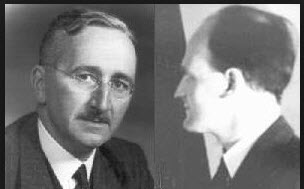It's been a debate had at the US Fed and our guest economist John Hearn gives us his take
Make sure you follow John on Twitter here and check all his blogs here
The Phillips Curve: The big mistake made by Keynesians
Professor A.W. Phillips would turn in his grave if he knew how the Keynesians had corrupted his curve.
In 1958 Bill Phillips published his paper entitled "The relation between unemployment and the rate of change of money wage rates in the UK 1861-1957" It confirmed a simple and obvious relationship between changes in wages and levels of employment. When unemployment was high and there was a pool of unused labour then wages tended to fall and when unemployment was low employers would have to bid up the price of labour to compete for a dwindling supply. This produced the original Phillips curve.
The curve was then hijacked by Keynesian economists who used the cost push inflation argument to transform wage rises into inflation and wage falls into deflation. Let us look firstly at this error of logic before we look at the damage that has been done by assuming it was right: there is no way that any rise in costs, including wages, can affect the average level of prices. Inflation and deflation are determined by the fact that there are more or less units of money in the same number of transactions. Wages, or any cost of production, do not increase or decrease the number of units of money in the economy. A Central Bank controls the supply of money and monetary demand and is therefore solely responsible for determining the rate of change of average prices.

It was therefore a mistake for Keynesian economists to corrupt the Phillips relationship and transform it into a function that could be used to predict the trend relationship between inflation and employment i.e. when inflation picks up more jobs will be created and vice versa. The 1960`s offered some solace for this idea as a stop-go cycle seemed to show some support for the function, but the need to maintain a fixed exchange rate under the gold exchange standard always stopped any attempt to use a fiscal deficit to boost aggregate demand in a sustainable way that would create more employment with the trade-off of a little more inflation.
The 1970`s exposed the lack of any credible support for the corrupted Phillips curve when stagflation occurred: see "What really happened in the 70s" on my blog jbhearn.wordpress.com. Stagflation is when a rise in inflation occurs alongside a rise in unemployment. Friedman had explained why a fiscal deficit and monetary expansion may have a brief positive effect on employment when he wrote about anticipated and unanticipated inflation. In the interim between a boost to demand taking place and the inflation occurring there is a period when firms may not anticipate the forthcoming inflation and mistake a general rise in demand for a particular rise in demand for their product. For a short while, when demand rises, profits increase and the firm expands. As this is happening to all firms at the same time so their costs begin to rise as they are competing for a limited number of productive factors.
The result is that they soon contract back to their original size. After that firms anticipate further inflation and they are not misled into expansion. Also if inflation rises further, as it did in the 70`s, so it masks relative price changes, markets stop functioning efficiently and unemployment rises as growth slows. Prime Ministers rarely say anything important, but in 1976 James Callaghan said "We used to think you could spend your way out of a recession and increase employment by cutting taxes and boosting government spending. I tell you in all candour that that option no longer exists, and in so far as it ever did exist, it only worked on each occasion since the war by injecting a bigger dose of inflation into the economy followed by a higher level of unemployment"
However, theoretical errors and a lack of real evidence did not stop Keynesian economists from arguing that the Phillips curve was still valid.During stagflation they argued it was just shifting its stable position from a lower level of unemployment to a higher level of unemployment; and what is even more worrying now is that influential economists are once again beginning to talk about a need to expand aggregate demand and move the world's major economies back to an inflation path with more employment and growth.
To conclude: The original Phillips curve showed a reasoned and empirically proven relationship between wages and levels of employmentTo transform wages into inflation requires an acceptance of a fallacious concept:- cost push inflation and the evidence of stagflations shows how inept any theory is when based on the corrupted Phillips curve.
As it is Keynesian demand management that has actually caused the major economies to suffer slow growth and recession characteristics (read "The cause of the EU/EZ/ worldwide continuing crisis", it is time to reintroduce the old Phillips curve to students, banish the inflation/employment curve from our thinking along with any further experiments with Keynesian economics.
John Hearn Oct 2015



